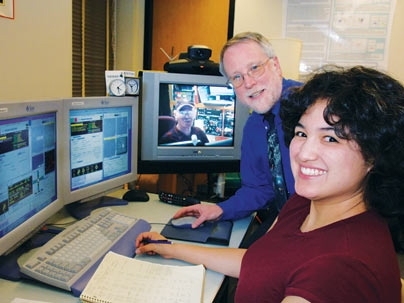Graduate student Cristina Thomas has been making observations of asteroids using a large NASA telescope in Hawaii, at least once a month for more than three years now. Doing this kind of astronomical research has traditionally required a lot of time and money for travel, but Thomas usually can get to the telescope just by walking down the hall.
Like dozens of students in Professor Richard Binzel's astronomy classes, Thomas gets to operate one of the world's leading infrared telescopes, perched 14,000 feet above sea level on the summit of Hawaii's extinct volcano Mauna Kea, without ever leaving the MIT campus.
NASA's Infrared Telescope Facility (IRTF), a three-meter telescope fitted with a variety of electronic cameras and spectrographs, is one of just a few in the world's prime astronomical locations that has been set up so that it can be controlled from anywhere in the world through a high-speed Internet connection. Astronomers anywhere can sit for hours in a convenient office and control the scope's motions with the click of a mouse, while watching the images it is capturing right on their computer monitors--just as they would do if they were on the mountaintop.
Actually controlling the huge scope is a complex bit of choreography, an interplay between a technician at the observatory in Hawaii, the student sitting in MIT's Green building and automated software that handles the finest-level autoguidance system.
Over a teleconferencing hookup, Dave, the technician in Hawaii, says the system is ready to go. Thomas clicks the "go" button on her monitor with a left-click of her mouse, and the display shows a black-and-white image of the star field. Thomas drags-and-drops a green box, using the mouse, so it is centered on the pinprick of light that is the target of this observing run--a tiny, faint asteroid. At that point, the autoguider takes over and keeps the object centered in the field.
Except that occasionally it doesn't. A brief blurring of the light because of air turbulence, or a wisp of cloud passing in front of the speck of light, has caused the autoguider to lose track. Thomas has to manually restart the process, and the autoguider takes over again.
This slow, tedious process can go on for 12 hours, starting at about midnight and running until noon (these are the nighttime hours in Hawaii, because of the difference in time zones). It may not be glamorous work, but it's a remarkable privilege for these students to be getting much time on one of the world's major telescopes.
In this case, their work may even help to save this planet from the risk of a devastating impact by a wayward chunk of space rock--the kind of disaster that the dinosaurs never saw coming, 65 million years ago. If an asteroid is ever found on a collision course with Earth, the best way of responding to the threat may depend on knowing what type of asteroid it is--whether it's a solid chunk of metal, or a crumbly mass of rocky debris.
Binzel and his students have been studying the composition of asteroids by training the IRTF telescope (and others) on them one by one, using spectrographs attached to those scopes to split the light into a spectrum that can reveal details of the object's composition. It's slow and tedious work but somebody's got to do it, for the sake of the planet's future.
Binzel, who has been working on getting spectra of asteroids for more than two decades, has secured regular observing time on the Hawaiian telescope that adds up to about one full night per month. Usually Binzel runs some of the observations himself, but his students get to do most of it, building up an impressive base of experience that can form the basis of an original thesis. Each night, they might manage to check off 20 asteroids from their list of potential targets.
Other students at Boston University, Harvard and other institutions also get to spend some time using the telescope every year, Binzel says, using similar control rooms set up on their campuses. In fact, it's possible to display the real-time images from any computer with a high-speed Internet connection. For example, Binzel was recently in Paris controlling the telescope from a similar setup and was able to send live images of a storm on Jupiter to an astronomer who was giving a talk at a conference in Athens.
Surprisingly few telescopes are equipped for this kind of remote observing, Binzel says. To share the benefits of the rare privilege, Binzel invites students in every class he teaches to take part in the observations, and dozens of them have taken advantage of the opportunity over the last few years.
The setup works best for observing programs like his, where the same types of objects are observed over and over, month after month, Binzel says. "If you're doing something new every time, there's a good reason to be there at the observatory, in case you need to adjust the experiment," he says.
For those students who are involved in a serious observing project--such as Thomas' thesis project on asteroid compositions--Binzel feels it's important to give them a chance to go to the observatory at least once. "It gives them a chance to see the entire operation," he says, so they can better understand what's going on when they later control the scope from on campus.
"It's an incredibly useful tool" for teaching astronomy, he says. "But you have to apply it correctly."
A version of this article appeared in MIT Tech Talk on March 19, 2008 (download PDF).






